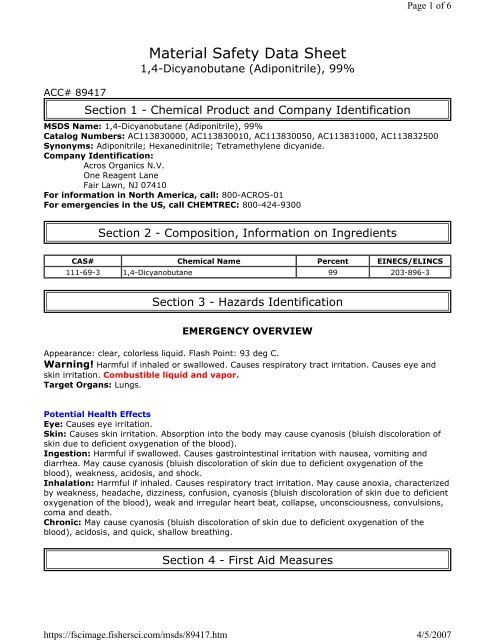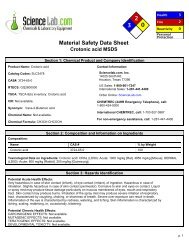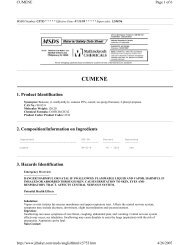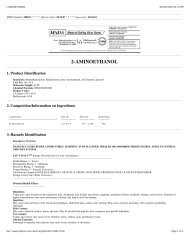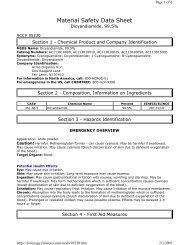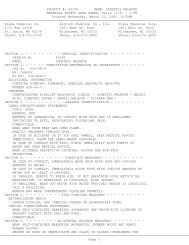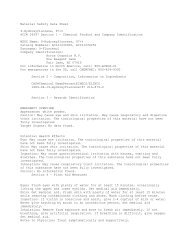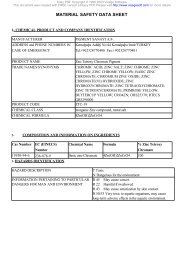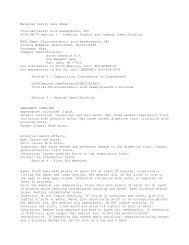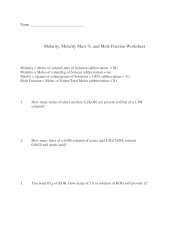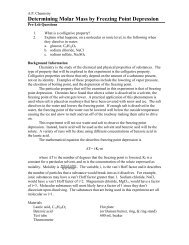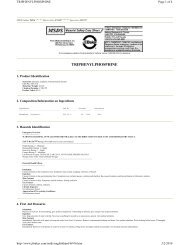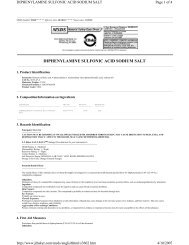MSDS PDF/A/Adiponitrile.pdf
MSDS PDF/A/Adiponitrile.pdf
MSDS PDF/A/Adiponitrile.pdf
You also want an ePaper? Increase the reach of your titles
YUMPU automatically turns print PDFs into web optimized ePapers that Google loves.
https://fscimage.fishersci.com/msds/89417.htm<br />
Page 1 of 6<br />
4/5/2007<br />
ACC# 89417<br />
Material Safety Data Sheet<br />
1,4-Dicyanobutane (<strong>Adiponitrile</strong>), 99%<br />
Section 1 - Chemical Product and Company Identification<br />
<strong>MSDS</strong> Name: 1,4-Dicyanobutane (<strong>Adiponitrile</strong>), 99%<br />
Catalog Numbers: AC113830000, AC113830010, AC113830050, AC113831000, AC113832500<br />
Synonyms: <strong>Adiponitrile</strong>; Hexanedinitrile; Tetramethylene dicyanide.<br />
Company Identification:<br />
Acros Organics N.V.<br />
One Reagent Lane<br />
Fair Lawn, NJ 07410<br />
For information in North America, call: 800-ACROS-01<br />
For emergencies in the US, call CHEMTREC: 800-424-9300<br />
Section 2 - Composition, Information on Ingredients<br />
CAS# Chemical Name Percent EINECS/ELINCS<br />
111-69-3 1,4-Dicyanobutane 99 203-896-3<br />
Section 3 - Hazards Identification<br />
EMERGENCY OVERVIEW<br />
Appearance: clear, colorless liquid. Flash Point: 93 deg C.<br />
Warning! Harmful if inhaled or swallowed. Causes respiratory tract irritation. Causes eye and<br />
skin irritation. Combustible liquid and vapor.<br />
Target Organs: Lungs.<br />
Potential Health Effects<br />
Eye: Causes eye irritation.<br />
Skin: Causes skin irritation. Absorption into the body may cause cyanosis (bluish discoloration of<br />
skin due to deficient oxygenation of the blood).<br />
Ingestion: Harmful if swallowed. Causes gastrointestinal irritation with nausea, vomiting and<br />
diarrhea. May cause cyanosis (bluish discoloration of skin due to deficient oxygenation of the<br />
blood), weakness, acidosis, and shock.<br />
Inhalation: Harmful if inhaled. Causes respiratory tract irritation. May cause anoxia, characterized<br />
by weakness, headache, dizziness, confusion, cyanosis (bluish discoloration of skin due to deficient<br />
oxygenation of the blood), weak and irregular heart beat, collapse, unconsciousness, convulsions,<br />
coma and death.<br />
Chronic: May cause cyanosis (bluish discoloration of skin due to deficient oxygenation of the<br />
blood), acidosis, and quick, shallow breathing.<br />
Section 4 - First Aid Measures
https://fscimage.fishersci.com/msds/89417.htm<br />
Page 2 of 6<br />
4/5/2007<br />
Eyes: Flush eyes with plenty of water for at least 15 minutes, occasionally lifting the upper and<br />
lower eyelids. Get medical aid.<br />
Skin: Get medical aid. Flush skin with plenty of water for at least 15 minutes while removing<br />
contaminated clothing and shoes. Wash clothing before reuse.<br />
Ingestion: Never give anything by mouth to an unconscious person. Get medical aid. Do NOT<br />
induce vomiting. If conscious and alert, rinse mouth and drink 2-4 cupfuls of milk or water.<br />
Inhalation: Remove from exposure and move to fresh air immediately. If not breathing, give<br />
artificial respiration. If breathing is difficult, give oxygen. Get medical aid. Do NOT use mouth-tomouth<br />
resuscitation.<br />
Notes to Physician: Treat symptomatically and supportively.<br />
Section 5 - Fire Fighting Measures<br />
General Information: As in any fire, wear a self-contained breathing apparatus in pressuredemand,<br />
MSHA/NIOSH (approved or equivalent), and full protective gear. During a fire, irritating<br />
and highly toxic gases may be generated by thermal decomposition or combustion. Use water<br />
spray to keep fire-exposed containers cool. Combustible liquid. Vapors may be heavier than air.<br />
They can spread along the ground and collect in low or confined areas. Contact with metals may<br />
evolve flammable hydrogen gas. Containers may explode when heated.<br />
Extinguishing Media: Use water spray to cool fire-exposed containers. Do NOT get water inside<br />
containers. For small fires, use dry chemical, carbon dioxide, or water spray. For large fires, use<br />
dry chemical, carbon dioxide, alcohol-resistant foam, or water spray.<br />
Flash Point: 93 deg C ( 199.40 deg F)<br />
Autoignition Temperature: 550 deg C ( 1,022.00 deg F)<br />
Explosion Limits, Lower:1.70 vol %<br />
Upper: 4.99 vol %<br />
NFPA Rating: (estimated) Health: 2; Flammability: 2; Instability: 0<br />
Section 6 - Accidental Release Measures<br />
General Information: Use proper personal protective equipment as indicated in Section 8.<br />
Spills/Leaks: Absorb spill with inert material (e.g. vermiculite, sand or earth), then place in<br />
suitable container. Avoid runoff into storm sewers and ditches which lead to waterways. Clean up<br />
spills immediately, observing precautions in the Protective Equipment section. Remove all sources<br />
of ignition. Provide ventilation. Do not get water inside containers.<br />
Section 7 - Handling and Storage<br />
Handling: Wash thoroughly after handling. Avoid contact with eyes, skin, and clothing. Empty<br />
containers retain product residue, (liquid and/or vapor), and can be dangerous. Keep container<br />
tightly closed. Keep away from heat, sparks and flame. Avoid ingestion and inhalation. Use with<br />
adequate ventilation. Wash clothing before reuse. Do not pressurize, cut, weld, braze, solder, drill,<br />
grind, or expose empty containers to heat, sparks or open flames.<br />
Storage: Keep away from heat, sparks, and flame. Keep away from sources of ignition. Store in a<br />
tightly closed container. Store in a cool, dry, well-ventilated area away from incompatible<br />
substances. Keep away from acids.
https://fscimage.fishersci.com/msds/89417.htm<br />
Page 3 of 6<br />
4/5/2007<br />
Section 8 - Exposure Controls, Personal Protection<br />
Engineering Controls: Facilities storing or utilizing this material should be equipped with an<br />
eyewash facility and a safety shower. Use adequate ventilation to keep airborne concentrations<br />
low.<br />
Exposure Limits<br />
Chemical Name ACGIH NIOSH OSHA - Final PELs<br />
1,4-Dicyanobutane<br />
2 ppm TWA; Skin -<br />
potential significant<br />
contribution to overall<br />
exposure by the cutaneous<br />
r oute<br />
4 ppm TWA; 18 mg/m3<br />
TWA<br />
none listed<br />
OSHA Vacated PELs: 1,4-Dicyanobutane: No OSHA Vacated PELs are listed for this chemical.<br />
Personal Protective Equipment<br />
Eyes: Wear appropriate protective eyeglasses or chemical safety goggles as described by OSHA's<br />
eye and face protection regulations in 29 CFR 1910.133 or European Standard EN166.<br />
Skin: Wear appropriate protective gloves to prevent skin exposure.<br />
Clothing: Wear appropriate protective clothing to prevent skin exposure.<br />
Respirators: Follow the OSHA respirator regulations found in 29 CFR 1910.134 or European<br />
Standard EN 149. Use a NIOSH/MSHA or European Standard EN 149 approved respirator if<br />
exposure limits are exceeded or if irritation or other symptoms are experienced.<br />
Section 9 - Physical and Chemical Properties<br />
Physical State: Liquid<br />
Appearance: clear, colorless<br />
Odor: None reported.<br />
pH: Not available.<br />
Vapor Pressure: 2.5 mbar @ 119<br />
Vapor Density: 3.7<br />
Evaporation Rate:Not available.<br />
Viscosity: Not available.<br />
Boiling Point: 295 deg C @ 760.00mm Hg<br />
Freezing/Melting Point:1.00 - 3.00 deg C<br />
Decomposition Temperature:Not available.<br />
Solubility: Slightly soluble.<br />
Specific Gravity/Density:.9510g/cm3<br />
Molecular Formula:C6H8N2<br />
Molecular Weight:108.14<br />
Section 10 - Stability and Reactivity<br />
Chemical Stability: Stable at room temperature in closed containers under normal storage and<br />
handling conditions.<br />
Conditions to Avoid: Incompatible materials, ignition sources, excess heat.<br />
Incompatibilities with Other Materials: Oxidizing agents<br />
Hazardous Decomposition Products: Nitrogen oxides, carbon monoxide, irritating and toxic<br />
fumes and gases, carbon dioxide, nitrogen.
https://fscimage.fishersci.com/msds/89417.htm<br />
Page 4 of 6<br />
4/5/2007<br />
Hazardous Polymerization: Has not been reported.<br />
Section 11 - Toxicological Information<br />
RTECS#:<br />
CAS# 111-69-3: AV2625000<br />
LD50/LC50:<br />
CAS# 111-69-3:<br />
Inhalation, rat: LC50 = 1710 mg/m3/4H;<br />
Oral, mouse: LD50 = 172 mg/kg;<br />
Oral, rabbit: LD50 = 22 mg/kg;<br />
Oral, rat: LD50 = 155 mg/kg;<br />
.<br />
Carcinogenicity:<br />
CAS# 111-69-3: Not listed by ACGIH, IARC, NTP, or CA Prop 65.<br />
Epidemiology: No data available.<br />
Teratogenicity: No data available.<br />
Reproductive Effects: No data available.<br />
Mutagenicity: No data available.<br />
Neurotoxicity: No data available.<br />
Other Studies:<br />
Section 12 - Ecological Information<br />
No information available.<br />
Section 13 - Disposal Considerations<br />
Chemical waste generators must determine whether a discarded chemical is classified as a<br />
hazardous waste. US EPA guidelines for the classification determination are listed in 40 CFR Parts<br />
261.3. Additionally, waste generators must consult state and local hazardous waste regulations to<br />
ensure complete and accurate classification.<br />
RCRA P-Series: None listed.<br />
RCRA U-Series: None listed.<br />
Section 14 - Transport Information<br />
US DOT<br />
Canada TDG<br />
Shipping Name: ADIPONITRILE No information available.<br />
Hazard Class: 6.1<br />
UN Number:<br />
UN2205<br />
Packing Group:<br />
III
https://fscimage.fishersci.com/msds/89417.htm<br />
Page 5 of 6<br />
4/5/2007<br />
Section 15 - Regulatory Information<br />
US FEDERAL<br />
TSCA<br />
CAS# 111-69-3 is listed on the TSCA inventory.<br />
Health & Safety Reporting List<br />
CAS# 111-69-3: Effective 6/1/87, Sunset 12/19/95<br />
Chemical Test Rules<br />
None of the chemicals in this product are under a Chemical Test Rule.<br />
Section 12b<br />
None of the chemicals are listed under TSCA Section 12b.<br />
TSCA Significant New Use Rule<br />
None of the chemicals in this material have a SNUR under TSCA.<br />
CERCLA Hazardous Substances and corresponding RQs<br />
None of the chemicals in this material have an RQ.<br />
SARA Section 302 Extremely Hazardous Substances<br />
CAS# 111-69-3: 1000 lb TPQ<br />
Section 313 No chemicals are reportable under Section 313.<br />
Clean Air Act:<br />
This material does not contain any hazardous air pollutants.<br />
This material does not contain any Class 1 Ozone depletors.<br />
This material does not contain any Class 2 Ozone depletors.<br />
Clean Water Act:<br />
None of the chemicals in this product are listed as Hazardous Substances under the CWA.<br />
None of the chemicals in this product are listed as Priority Pollutants under the CWA.<br />
None of the chemicals in this product are listed as Toxic Pollutants under the CWA.<br />
OSHA:<br />
None of the chemicals in this product are considered highly hazardous by OSHA.<br />
STATE<br />
CAS# 111-69-3 can be found on the following state right to know lists: New Jersey,<br />
Pennsylvania, Minnesota, Massachusetts.<br />
California Prop 65<br />
California No Significant Risk Level: None of the chemicals in this product are listed.<br />
European/International Regulations<br />
European Labeling in Accordance with EC Directives<br />
Hazard Symbols:<br />
T<br />
Risk Phrases:<br />
R 23/25 Toxic by inhalation and if swallowed.<br />
R 36/37/38 Irritating to eyes, respiratory system and skin.<br />
Safety Phrases:<br />
S 45 In case of accident or if you feel unwell, seek medical advice<br />
immediately (show the label where possible).<br />
WGK (Water Danger/Protection)<br />
CAS# 111-69-3: 1<br />
Canada - DSL/NDSL<br />
CAS# 111-69-3 is listed on Canada's DSL List.<br />
Canada - WHMIS
https://fscimage.fishersci.com/msds/89417.htm<br />
Page 6 of 6<br />
4/5/2007<br />
This product has a WHMIS classification of D1B, D2B.<br />
This product has been classified in accordance with the hazard criteria of the Controlled Products<br />
Regulations and the <strong>MSDS</strong> contains all of the information required by those regulations.<br />
Canadian Ingredient Disclosure List<br />
CAS# 111-69-3 is listed on the Canadian Ingredient Disclosure List.<br />
Section 16 - Additional Information<br />
<strong>MSDS</strong> Creation Date: 12/18/1998<br />
Revision #4 Date: 3/04/2004<br />
The information above is believed to be accurate and represents the best information currently available to us. However, we make<br />
no warranty of merchantability or any other warranty, express or implied, with respect to such information, and we assume no<br />
liability resulting from its use. Users should make their own investigations to determine the suitability of the information for their<br />
particular purposes. In no event shall Fisher be liable for any claims, losses, or damages of any third party or for lost profits or any<br />
special, indirect, incidental, consequential or exemplary damages, howsoever arising, even if Fisher has been advised of the<br />
possibility of such damages.


